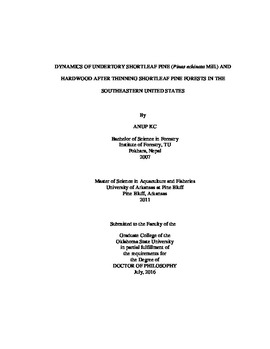| dc.contributor.advisor | Lynch, Thomas B. | |
| dc.contributor.author | KC, Anup | |
| dc.date.accessioned | 2017-02-22T22:09:44Z | |
| dc.date.available | 2017-02-22T22:09:44Z | |
| dc.date.issued | 2016-07 | |
| dc.identifier.uri | https://hdl.handle.net/11244/48823 | |
| dc.description.abstract | The shortleaf pine (Pinus echinata Mill.) population is consistently declining in southeastern United States. Shortleaf pine forests are thinned frequently to improve the growth and development of residual stands. But, the effect of thinning on growth and development of understory woody-plants in long term has not been extensively studied. We assessed the effects of thinning, overstory shortleaf pine characteristics, climatic, and topographic factors on shortleaf pine regeneration applying various predictive modeling techniques. We applied decision tree models to predict shortleaf pine regeneration. We also developed, evaluated, and compared the performance of three other predictive models to predict shortleaf pine regeneration. We used understory shortleaf pine data that were collected from shortleaf pine forests of Arkansas and Oklahoma spanning a period of 25 years following thinning and hardwood control treatments. The shortleaf pine densities have declined in every subsequent measurement since the first measurement of understory trees in 1996. Thinning treatments played a significant role on the understory shortleaf pine density. The decision tree model using the Gini criteria as the splitting rule to predict the shortleaf pine regeneration had a low misclassification rate of 7.6 percent. The decision tree model can be an efficient tool to make shortleaf pine stand management decisions. The best performing logistic regression model showed precipitation, plot age, site index, and overstory thinning were the significant inputs affecting shortleaf pine regeneration with validation misclassification rate of 8 percent. The best performing artificial neural network model predicted the shortleaf pine regeneration with validation misclassification rate of 7.6 percent, and cumulative lift of 5, 2.5 and 1.66 at depth of 20, 40 and 60 respectively. An artificial neural network model performed best to predict the shortleaf pine regeneration. Poor shortleaf pine regeneration performance over decades in study sites suggests the future of shortleaf pine dominated forests is questionable unless further regular silvicultural treatments are applied. We recommend continual hardwood removal every 10-15 years to obtain the satisfactory understory shortleaf pine regeneration in shortleaf pine forests of Arkansas and Oklahoma. | |
| dc.format | application/pdf | |
| dc.language | en_US | |
| dc.rights | Copyright is held by the author who has granted the Oklahoma State University Library the non-exclusive right to share this material in its institutional repository. Contact Digital Library Services at lib-dls@okstate.edu or 405-744-9161 for the permission policy on the use, reproduction or distribution of this material. | |
| dc.title | Dynamics of understory shortleaf pine (Pinus echinata Mill.) and hardwood after thinning shortleaf pine forests in the southeastern United States | |
| dc.contributor.committeeMember | Zhu, Lan | |
| dc.contributor.committeeMember | Will, Rod | |
| dc.contributor.committeeMember | Hallgren, Stephen | |
| osu.filename | KC_okstate_0664D_14713.pdf | |
| osu.accesstype | Open Access | |
| dc.type.genre | Dissertation | |
| dc.type.material | Text | |
| thesis.degree.discipline | Natural Resource Ecology and Management | |
| thesis.degree.grantor | Oklahoma State University | |
